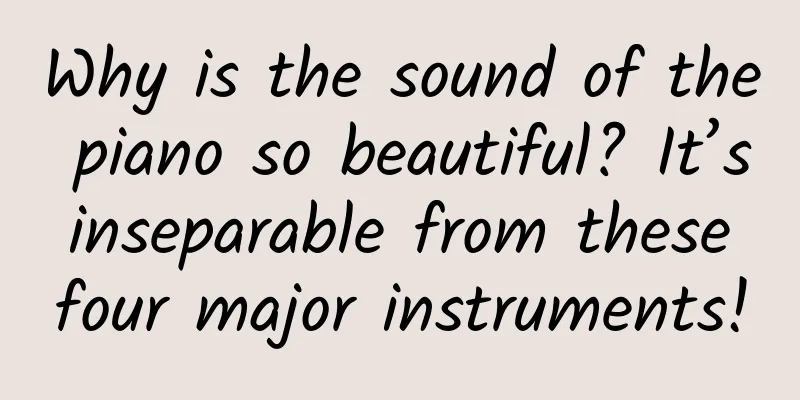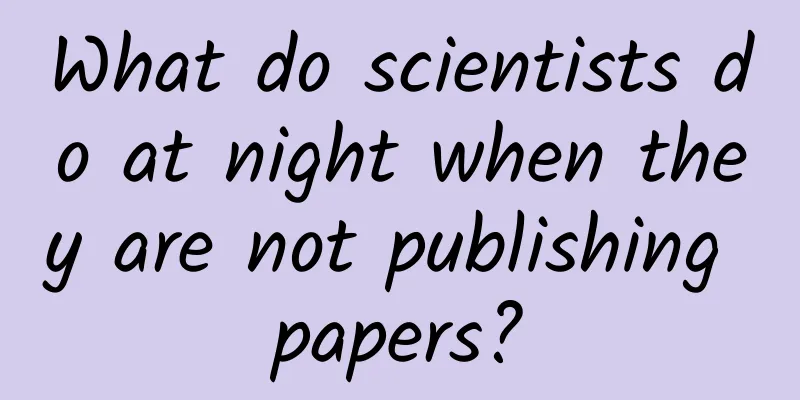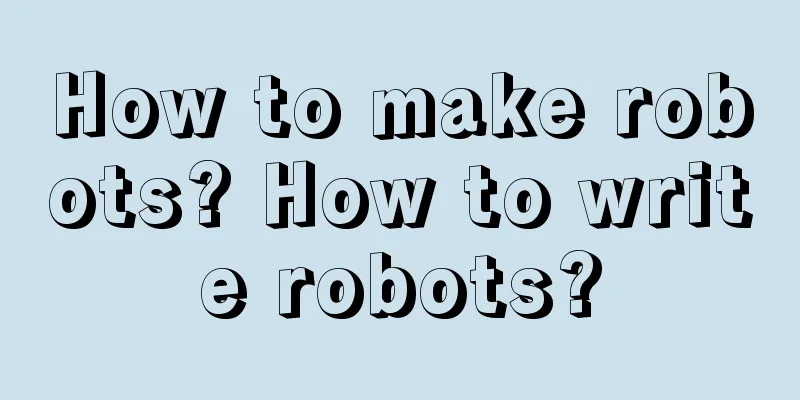Why is the sound of the piano so beautiful? It’s inseparable from these four major instruments!

|
When it comes to the piano, many students who have suffered from the "torture" of piano tuition classes may feel scared, and the neighbors are probably also suffering from the noise. While practicing your piano skills, have you ever thought about how the piano produces those beautiful sounds? As a keyboard instrument originating from the West, the piano has the characteristics of wide range, loud volume, beautiful timbre and rich expressiveness. Almost all famous modern and contemporary Western musicians such as Bach, Mozart, Beethoven, Schubert and Liszt have composed music specifically for the piano. Therefore, the piano is known as the "king of musical instruments". So what secrets are hidden in that huge box that allowed it to win this honor? Common upright and horizontal pianos Image source: an e-commerce platform In fact, the principle of piano sound production is not mysterious. It is the same principle as the sound produced by all objects around us, that is, vibration. Imagine: the top of the flagpole will swing back and forth in windy weather; a spring will continue to expand and contract back and forth after being stretched and released; the drumhead will rise and fall when struck by a drumstick... These phenomena all have the same characteristic, that is, objects move back and forth near a certain position. This phenomenon is called mechanical vibration (vibration for short). This knowledge point is covered in the People's Education Edition's high school physics elective course. Different objects vibrate at different speeds. For example, the speed at which a hummingbird flaps its wings is significantly higher than that of a goose. This vibration speed is usually expressed in terms of vibration frequency, which refers to the number of times an object vibrates per unit time, and its unit is Hertz (Hz). Scientists have discovered that the human ear's hearing range is 20-20,000 Hz. When the frequency of an object's vibration reaches this range, it can be felt by the eardrum and the auditory nerve in the brain. Only then will we think that an object makes a sound. When the vibration of the sound source is relatively soft, we will feel it is pleasant and pleasing to the ear; when the vibration of the sound source is violent, we will feel it is harsh. The hearing range of many small animals is much wider than that of humans, so their hearing is very sensitive and can hear some infrasound and ultrasound waves that we cannot perceive. The piano is a very sophisticated device, consisting mainly of a casing, keyboard mechanism, strings, soundboard and pedals, with all the parts adding up to thousands of parts. Among them, keyboard mechanism, strings and soundboard are the three major weapons that enable the piano to produce pleasant sounds. The main structure of the piano, source: Sohu Yes, that's right. There are many strings installed inside the piano, and the sound of the piano originally comes from the vibration of the strings. However, these strings are in a taut state and there is a huge tension inside them. All the strings add up to 15-20 tons, so we cannot pluck these strings with our fingers like playing the guitar. The role of the keyboard mechanism is to use the principle of leverage to make the strings vibrate by simply pressing the keys. Therefore, the keyboard mechanism is a very important component and is called the "heart" of the piano. Keyboard mechanism and the strings connected to it, source: Zhihu A keyboard mechanism is mainly composed of a number of keys and the same number of action mechanisms. The action mechanism is mainly composed of linkage levers, turners, hammers, stop levers and other parts. The hammers hit the strings to make them vibrate and produce sound. Illustration of a single action, source see watermark When we press a key, a series of lever mechanisms inside the action connected to the key begin to move, allowing the hammer at the end to strike the corresponding string forcefully, causing the string to vibrate and make a sound. When a key is pressed, the corresponding sound can continue to sound. This is because a special escapement mechanism is installed in the action, which ensures that the hammer will immediately disengage from the string after striking it once, without affecting the subsequent free vibration of the string. When we release the keys, the keys rebound and the damper on the action immediately contacts the strings, causing them to stop vibrating and making no sound. This timely damping device can make the piano sound crisp and clear. The following animated image shows the process of the action striking the strings and damping them. The working process of the action, source: 360doc The piano strings vary in length and thickness, and the sounds they produce are also unique. The shorter and thinner the strings, the higher the vibration frequency, and the sharper the sound; while the longer and thicker the strings, the lower the vibration frequency, and the deeper the sound. The force with which we press the keys can also control the timbre of the sound. This is because the pressure can control the speed at which the hammer hits the strings, which in turn affects the timbre of the sound. Excellent pianists are generally able to master the structure and basic principles of the keyboard mechanical system, and can make fine adjustments to the action during tuning to achieve the best sounding effect of the piano. However, for public performances, the volume of the strings alone is far from enough. For this reason, a special soundboard is installed inside the piano to amplify the sound of the strings using the principle of resonance. Resonance is a physical concept related to the natural frequency of an object. It has been mentioned in high school physics textbooks that the frequency of an object when it is in a state of free vibration is called the natural frequency. This characteristic has nothing to do with external factors and is only related to the object's own properties. In other words, every object has its own unique vibration rhythm. When the rhythm of the external force on an object is the same as its own vibration rhythm, the object will vibrate quite obviously. Resonance is very common in our lives. The glass of buildings on the roadside will sway gently as cars pass by, conch shells will emit roars similar to the sound of waves, and trumpets and flutes can produce loud sounds by blowing gently. These are all resonance phenomena. The soundboard of a piano is made of a very thin piece of wood that is uniform in texture, slightly curved, and has good elasticity. When the piano strings vibrate, the soundboard next to them will vibrate synchronously due to resonance. Since the surface area of the soundboard is larger, the vibration amplitude is much greater than that of the strings, so the sound of the strings can be evenly transmitted to the surrounding air, thereby amplifying the sound. It is not difficult to see that the quality of the piano sound is closely related to the sound amplification performance of the soundboard. Research has found that the acoustic performance of the soundboard is not only related to its shape, thickness and dryness, but also to many factors such as wood density, fiber length, fiber orientation and the microscopic structure of wood cells. At present, high-quality piano manufacturers at home and abroad all use spruce or fish-scale pine wood to make solid wood soundboards to obtain higher piano sound quality. The soundboard being made, source: Sohu The piano is usually equipped with three pedals: left, middle and right. They can also affect the effect of the piano sound and are similar to game plug-ins. Pressing the left pedal can reduce the sound of the piano by one third, which is called the soft pedal; pressing the right pedal can prevent the sound from stopping immediately after the key is released, which is called the sustain pedal. The middle pedal has different functions in different pianos. For example, some can greatly reduce the volume of the piano to facilitate our practice; some can make the sound of a specific key have a sustain effect. Piano pedals The flexible use of the pedal can add the finishing touch to piano performance. Chopin, the "Piano Poet", is famous for his superb pedal skills and has created many beautiful melodies. Now we know that the sound-producing principle of the piano is not mysterious. The keyboard is the "fingers" of the piano, used to strike the strings; the strings are the "voice" of the piano, used to vibrate and produce sound; and the soundboard is the "loudspeaker" of the piano, used to transmit the piano sound with high quality. Of course, if you want to play beautiful music, you also need a creative "brain". Do you have one? References: 1. High School Physics Elective 1, Compulsory Education Textbook, People's Education Press, 2007. 2. Zhang Zhihe, Liu Jinshou, Wang Yanliang, et al. Piano Learning and Use Guide [M]. Shenyang: Liaoning Education Press, 1994.02. END Author: Liuhuo, Engineer, 203 Research Institute of Ordnance Industry Editor: Guru |
<<: Seal, you can swim, why are you always pulled out of the water?
>>: How to transport the long wind turbine blades up the mountain? Here comes the answer
Recommend
The sleep bug used by Sun Wukong, you have actually seen it! 丨Bolan Daily
Hard drive full again? This "super CD" ...
An aircraft that can swim - the amphibious aircraft "Kunlong"
Science Fiction Network, November 30 (Xu Mingyang...
OnePlus completely closes offline stores: input costs and outputs do not match
After a year and a half, OnePlus finally returned...
China's new energy vehicle sales increased by 19.3% year-on-year in July, but Tesla's sales in China fell by 24% month-on-month
Although China's new energy market has experi...
Is the weather forecast always a lie? AI makes the weather more predictable
We are probably accustomed to the real-time weath...
Say goodbye to the background power consumption and traffic theft of mainstream anti-self-starting software horizontal experience
The battery of mobile phones has not improved, and...
They account for half of winter vegetables, but are said to be unsafe and nutritious? Off-season vegetables are so unfair!
Author: Wang Lu, Chinese registered dietitian, Ma...
Little Printf's Programming Story: Chapter 1
[[160813]] The original author, Fred Hebert, is a...
How to make money with Kuaishou film and television account, how to make money using Kuaishou?
Kuaishou is one of the most popular short video p...
For promotion on Xiaohongshu, just read this article.
This article will try to answer your questions: 1...
Customer acquisition and conversion methods: applicable to both e-commerce and knowledge payment
Recently many friends have asked me why other peo...
WeChat launches "Transportation Card", which can integrate 136 cities' ride codes and is already in grayscale testing
Recently, the "Transportation Card" ser...
Android Security: Intent Scheme Url Attack
0X01 Introduction Intent scheme URL is a special ...
16 negotiations for 2 seconds! That night 25 years ago...
2 seconds, 23 seconds, 12 seconds There is a stor...









